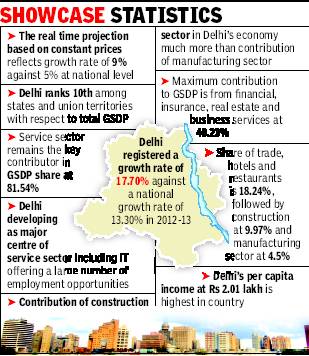Delhi: Economy
This is a collection of articles archived for the excellence of their content. the Facebook community, Indpaedia.com. All information used will be acknowledged in your name. |
Contents |
Developmental/ economic indicators
2014-15
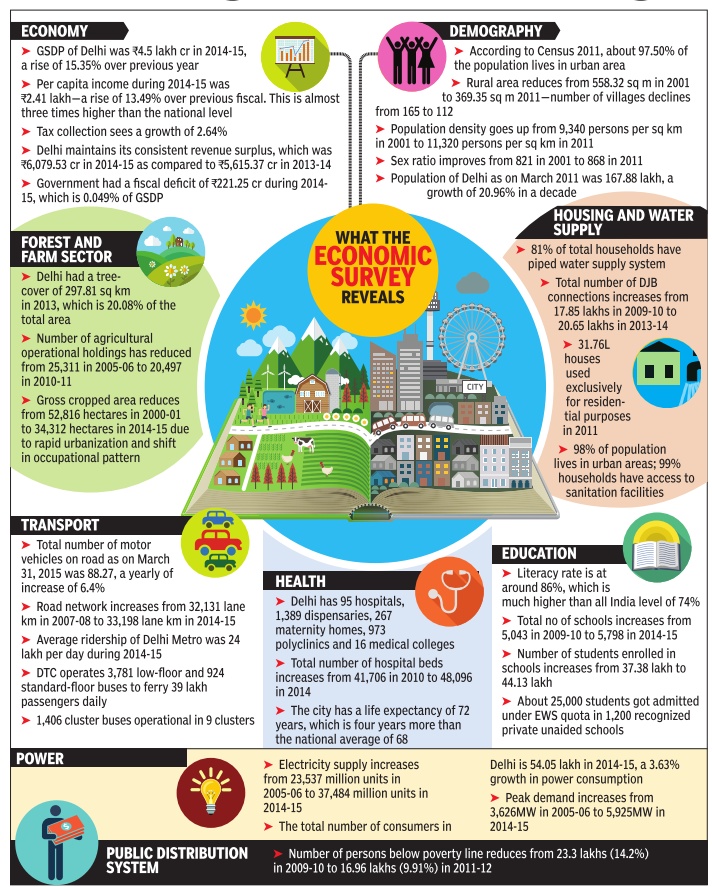
See graphic: Delhi Economy, demography, forest and farm sectors, housing and water supply, transport, health, education and power (2014-15)
2015-16

See graphic, Delhi, 2016, some economic indicators
2015> 2017

From: March 20, 2018: The Times of India
See graphic: Delhi, 2015- 2017, some economic indicators
Delhi, 2015- 2017, some economic indicators
2018-19: health, education, transport
Sidhartha Roy, January 22, 2021: The Times of India

From: Sidhartha Roy, January 22, 2021: The Times of India
Just 2.6% of Delhiites suffer from chronic illnesses, while a third of this population suffers from diabetes, followed by hypertension, cardiac diseases and respiratory ailments. This was revealed by the socio-economic survey carried out by Delhi government, which covered over one crore people.
The survey conducted by 6,000 field workers covering more than 20 lakh households also revealed that 72.8% Delhiites got medical treatment from government-run hospitals or dispensaries and 27.2% of the population visited private hospitals or clinics. The survey was conducted between November 2018 and November 2019 and finalised in November last year.
Among those suffering from chronic and persistent illnesses were 50.3% male and 49.7% female patients. The highest proportion of the population with chronic illnesses (36.3%) was found suffering from diabetes, followed by 21.7% from cardiac illnesses, including hypertension and blood circulatory disease, and 9.2% from respiratory diseases. Other illnesses included TB, thalassemia and cancer. In all, 24.3% people were reported suffering from joint pain, arthritis, etc.
Most diabetes patients were reported from Central district (43.3%), while the highest proportion of cardiac patients were in North West district (26.2%). The highest number of patients with re- spiratory disease were reported from North district (11.6%).
Among males, 37.1% had diabetes as chronic illness, compared with 35.5% in females. The proportion of other illnesses, including joint pains, was 23.5% in males and 25% in females, while cardiac illness was higher in females (25%) compared with males (23.5%).
According to the survey, 77.5% of children in the age group of 0-5 years had received or were receiving vaccination.
The highest proportion of the population getting medical treatment from public healthcare facilities was in North East district (78.4%), followed by North district (77.2 %). On the other hand, 37% of the population in South East district preferred getting medical treatment at private healthcare facilities, followed by East district (30%). The study mentioned that 69.8% of the population used public transport, including Delhi Metro and buses, to commute to their workplace, educational institutions or other destinations. The section of population that used personal transport was 15.7%, including 15.4% that used two-wheelers and 0.3% that travelled by cars. The top three districts where the number of people using personal vehicles were Shahdara (21.5%), East (18.4%) and West (16.5%) districts.
The largest number of Delhi Metro users were in New Delhi district (10.9%) and the highest proportion of bus users in North district (75.2%). Public buses (68.3%) were the preferred mode of transport for the female population, followed by shared autorickshaw, e-rickshaw or cabs (14.9%), two-wheelers (6.8%) and Delhi Metro (6.7%).
The survey revealed that the effective literacy rate (for people aged 7 years and above) was 88.5%, whereas the crude literacy rate (for all ages) was 85.8%. Most children in the age group of 6-17 years were reported to be enrolled in educational institutions (90.2%), while 52.5% were studying in Delhi government-run schools.
Among the 9.8% children in the age group of 6-17 years who had dropped out of school, discontinued education or had never attended an institute, the predominant reason was financial constraint (29.2%). Among the children in the age group of 0-6 years, 55.4% children were reported to be attending Anganwadi centres.
In all, 43.3% of senior citizens were reported to be receiving pension from Delhi government, while 47.2% of pregnant women were attending Anganwadi centres for availing healthcare.
2019-20: state GDP grew by 7.4%
AlokKN Mishra, March 24, 2020: The Times of India
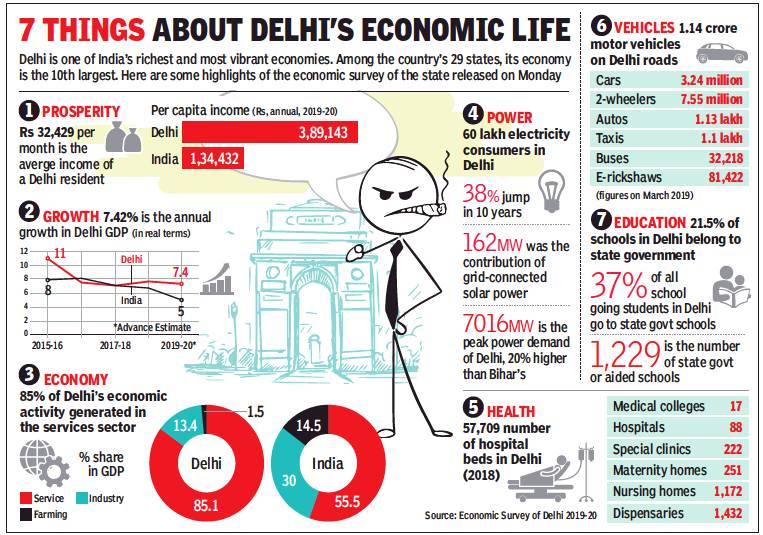
From: AlokKN Mishra, March 24, 2020: The Times of India
Against the slower national GDP growth of 5%, Delhi economic growth was estimated at a healthier 7.4% in 2019-20. According to Delhi’s Economic Survey 2019-20, tabled in the state assembly on Monday, the tax collection, however, registered a growth of only 2.5% in 2018-19, far lower than the 14.7% reported in 2017-18.The decline in the growth reflected the condition of the national economy.
The survey appeared to bely apprehensions that subsidies given by the Aam Aadmi Party government, such as free electricity, free bus rides for women and free pilgrimage for senior citizens, would negatively impact the revenues of the state. Despite the money spent on these amenities, the size of the annual budget doubled to Rs 65,000 crore in 2020-21.
The state economy was reported to be on a steady footing, with the average Delhiite continuing to earn three times more than the average Indian. The city’s per capita income at current prices has been determined to be Rs 3,89,143, a rise of 8.6% from Rs 3,58,430 in 2018-19. Delhi’s Gross State Domestic Product at current prices in 2019-20 is Rs 8,56,112 crore, a growth of 10.5% over the previous year. GSDP has increased around 55% in the past five years from Rs 5,50,804 crore in 2015-16 to Rs 8,56,112 crore in 2019-20. The services sector was the major revenue booster, with a share of Gross State Value Added Tax at 85.2% in 2019-20, followed by secondary sector (manufacturing) at 13.4% and primary sector (agriculture) 1.5%. The services sector also plays a pivotal role in employment generation.
The state excise recorded the highest growth ever of 12.9% in 2018-19. Tax collections under the heads of stamp and registration tax (including land revenue) and GST (including VAT and other taxes) recorded a growth, respectively, of 8.3% and 0.2%. However, collections of motor vehicles tax showed negative growth of 2.9%.
These taxes accounted for 85% of the state government’s total revenue receipts in 2018-19. All components of the tax revenue indicated a higher growth in 2018-19, except for VAT (petrol, diesel, liquor, etc), taxes on Vehicles and other taxes & duties on goods & services (entertainment tax, luxury tax, etc). The government is expecting a tax collection of Rs 44,100 crore in 2020-21.
The survey revealed that Delhi government had debt under control. The outstanding debt stood at Rs 29,608.3 crore in 2011-12, which was equal to 8.6% of the GSDP then. In 2018-19, with an outstanding debt of Rs 32,732 crore as on March 31, 2019, the debt-to-GSDP ratio had declined substantially to 4.2%. This has helped Delhi to maintain a consistent revenue surplus, which was calculated at Rs 6,261 crore in 2018-19 compared with Rs 4,913 crore in 2017-18.
Being in the black allowed the state government to make fund allocations to different sectors and plan and implement various public welfare schemes. In the financial year 2019-20, education had been the priority sector for the government with a maximum share of the budgetary allocations at 28.9%, followed by housing & urban development (14.5%), medical and public health (13.9%) and transport (13.7%) According to the Delhi Economic Survey, the capital’s infant mortality and neonatal mortality rates are below the national-level averages. At the same time, the total fertility rate of Delhi is lowest among all the states of India. In the last five years the total number of hospital beds also increased from 48,096 in 2014 to 57,709 in 2018.
2020-21: better than the national average
March 9, 2021: The Times of India

From: March 9, 2021: The Times of India
Delhi GSDP dip (5.7%) less than 8% GDP drop
New Delhi:
Hit by the Covid pandemic, Delhi’s per capita income has declined by Rs 22,217 and Gross State Domestic Product (GSDP) has shrunk by 5.7% during 2020-21. That contraction is, however, far less than the decline of 8% at the national level during the same period.
According to Delhi’s Economic Survey 2020-2021, tabled by deputy CM Manish Sisodia in the assembly on Monday, despite the decline in per capita income, the average Delhiite earns three times more than the average Indian. Delhi’s per capita income during 2020-21 at current prices has been worked out to be Rs 3,54,004 as against Rs 3,76,221 during 2019-20. Delhi’s GSDP had increased by around 45% in the past six years.
Sisodia said the GSDP contraction was relatively less “because the Delhi government took timely steps to revive the economy.”
Survey Predicts Sharp Economic Recovery
Double-Digit Growth Expected Due To Low Base, Boost To Consumption & Investment Amid C-Vax Drive
The steps include early lifting of the lockdown, starting of hotels and public transport etc. which was a huge boost to the process of economic recovery.” He added that the Delhi government also gave substantial cash transfers to the people of Delhi through various subsidies, which amounted to a monthly savings of Rs 2,500 for an average family, apart from financial assistance to auto and taxi drivers and construction workers during the lockdown. “This money was spent by people in local markets which gave a boost to the economy,” he said.
Hopes of a robust recovery in the services sector, consumption and investment have been rekindled now with the vaccination drive addressing the pandemic issue, according to the survey. In 2021-22, a sharp recovery of real GSDP of Delhi with double digit growth is expected based on a low base effect and inherent strengths of the economy. As a general phenomenon observed in most of the urban economies, Delhi is also showing a trend of higher share in the services sector. This sector was a major revenue booster with a share of Gross State Value Added Tax at 82.8% in 2020-21, followed by the secondary sector at13.7% and the primary sector at 3.4%. The services sector also plays a pivotal role in employment generation.
Tax collection registered a negative growth of 0.2% during 2019-20 (provisional) as compared to a growth of 2.5% in 2018-19. Stamps and registration tax (including land revenue) recorded the highest growth of 3.4% in 2019-20 (provisional). However, GST (including VAT and other taxes like luxury and entertainment etc.) and motor vehicles tax have shown a negative growth of 0.6% and 5.2%, respectively.
The tax collection for 2020-21 is budgeted with a growth of 20.60% over the previous year. The government has received small savings loan of Rs 4,540.60 crore during 2019-20 (provisional) as against Rs 2,800 crore in 2018-19. It is expecting a tax collection of Rs 55,309 crore in 2020-21 (budget estimate) with a growth of 17.3% over the previous year.
The total revenue collection of Delhi government was Rs 47,135.81 crore (5.7% of GSDP) in 2019-20 as against Rs 43,112.61 crore (5.7% of GSDP) during 2018-19. During 2019-20 (provisional), revenue receipts increased significantly with a growth rate of 9.3%, mainly due to increase in grants and other receipts from the Centre (nontax revenue). However, the growth of own non-tax revenue of the Delhi government saw a significant growth of 70.3% in 2019-20 as against a negative growth of 15.9% in 2018-19. There was a decline in growth from 167.5% in 2018-19 in grants and other receipts from the central government to 62.1% in 2019-20. The overall expenditure of Delhi in the year 2019-20 was marginally lower than its income, according to the survey. In 2019-20, with an outstanding debt of Rs 34,461.83 crore as on March 31, 2020, the debt GSDP ratio had declined substantially to 4.1% as compared to 8.6% in 2011-12. This has helped Delhi to maintain a consistent revenue surplus, which was calculated at Rs 7,499 crore in 2019-20 compared with Rs 6,261 crore in 2018-19.
In the financial year 2020-21, the education sector remained a priority sector with a maximum allocation of 23.8% (highest among all states) followed by transport (14.7%) and medical and public health (13.4%).
Transport
During 2019-20, a total of 10.6 crore free trips in Delhi Transport Corporation buses and 8.7 crore free trips in cluster buses were made by women passengers, thanks to the provision of free travel provided by the Delhi government. It also launched an electric vehicle policy in August 2020, which targets a 25% share of electric vehicles in all new vehicle registrations by 2024.
Delhi Jal Board
The coverage of water supply network in under-served areas has gone up and 1,571 unauthorised colonies (87%) have been covered. Over 93% of households in the capital now have access to piped water supply in comparison to 83.4% reported in last year’s survey. Two million additional people are now getting piped water.
Education
Out of 44.76 lakh students enrolled in schools, a majority are in private schools — 37.2% are enrolled in government and aided schools and 42.6% in private schools. There is an upward trend in the literacy rate for both male and female. The literacy rate of 75.3% in 1991 increased to 86.2% in the 2011 census and further to 88.7% in 2017-18. However, a gap of 11% between male and female literacy remains a cause for worry.
2021-22
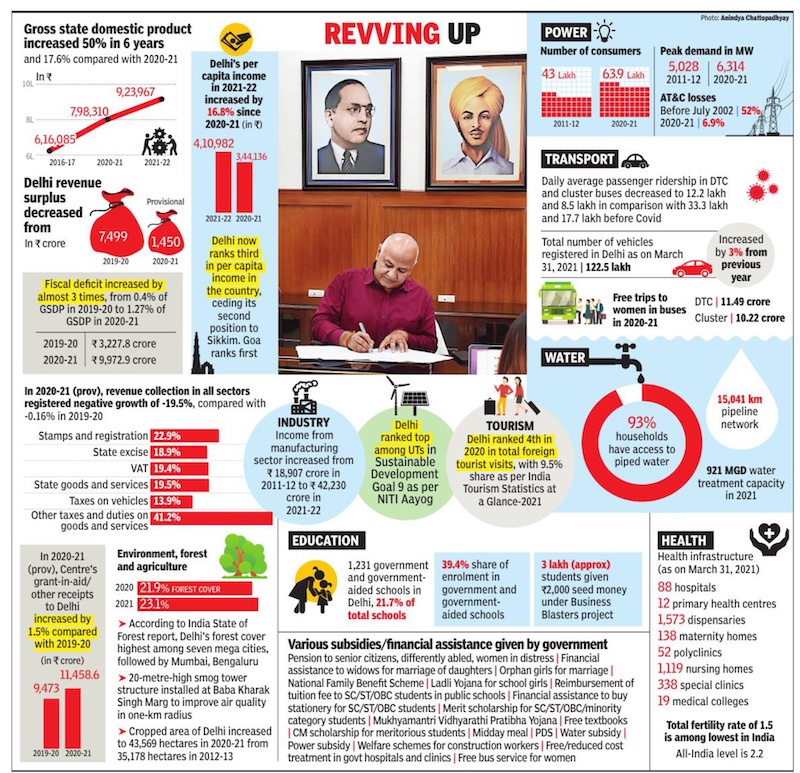
From: March 26, 2022: The Times of India
See graphic:
Delhi’s Economy in 2021-22
2022 – 23
January 7, 2023: The Times of India

From: January 7, 2023: The Times of India
NEW DELHI: Delhi planning minister Atishi said AAP government set new benchmarks in the field of public services in 2023 despite facing various challenges.
Releasing 'Statistical Handbook-2023', which has been prepared by the department of economics and statistics, Atishi said her government remained focused on the welfare of people, which reflected the way the per capita income increased more than 150% than the national average and minimum wages of skilled and unskilled workers were set highest in the country.
Sharing the highlights of the handbook, Atishi said the per capita income increased from Rs 3,89,529 in 2021-22 to Rs 4,44,768 in 2022-23 fiscal registering a 14% growth, while the national average was Rs 1,72,276. "This means Delhi's per capita income is 158% more than the national average," she said.
Talking about the city's public transport, Atishi said Delhi now had more than 7,200 buses running under DTC and cluster bus scheme, of which 1,300 were electric. "Kejriwal government has worked to enhance public transportation services in Delhi. As a result, in 2023, more than 41 lakh commuters travelled every day on DTC and cluster buses," she said.
"Delhi is leading the electric vehicle revolution in the country. In the year gone by, the number of electric buses in the capital has increased to 1,300, surpassing all other states of the country," Atishi added.
Bus ridership reached the pre-Covid levels. In 2018-19, DTC and cluster buses together carried nearly 42 lakh passengers every day. The number fell down drastically during the two years of Covid-19. In 2021-22, the average daily ridership in public buses was recorded at nearly 25 lakh.
Talking about the power sector, Atishi said nearly 2.8 lakh new electricity consumers were added in 2023. "Despite the increased demand, Kejriwal government has successfully provided uninterrupted electricity supply in all parts of Delhi. The electricity consumption in the capital has increased by 859 million units (85.9 crore) in 2023," she said, adding that more than 3.4 crore zero electricity bills were generated in the last fiscal of 2022-23. The year 2023 also saw over one lakh new consumers adding to the piped water network.
On the social front too, said Atishi, AAP government did a lot of work in the past few years. Quoting the statistical handbook, Atishi said there were over 4 lakh senior citizens who were availing of the monthly pension given by government while 1.7 lakh girls benefited from the Ladli scheme.
"Also, 11,570 people benefited from Chief Minister's Covid-19 Family Financial Assistance Scheme," she said.
Details
Atul Mathur & Abhinav Rajput, January 13, 2024: The Times of India

From: Atul Mathur & Abhinav Rajput, January 13, 2024: The Times of India
Delhi Slips Behind B’luru In No. Of Pvt Cars
STATISTICAL HANDBOOK: Water Consumption & Losses Down, Number Of Movie Goers Up From Previous Year
Atul Mathur & Abhinav Rajput TNN
New Delhi : It was the city’s boast once that it had more private cars than Chennai, Mumbai and Kolkata combined. But Delhi no longer holds the record of having the highest number of private cars in an Indian city. With more than 23.1 lakh, Bengaluru has overtaken Delhi in this regard. Till March 31, 2023, Delhi had 79.5 lakh vehicles, of which 20.7 lakh were private cars.
As per Delhi Statistical Handbook 2023, the total number of vehicles registered in the capital stood at 1.2 crore, of which 33.8 lakh were private cars. But in the last couple of years, the transport department has not only deregistered overaged vehicles, but also scrapped many that were in a condemned state.
In 2021-22 and 2022-23, almost 55 lakh cars were de-registered, 1.4 lakh were scrapped and more than 6.2 lakh availed of no-objection certificates to re-register in other states. The Supreme Court had banned diesel and petrol vehicles older th an 10 and 15 years, respectively, in Delhi in 2018. The government was asked to take strict action, including deregistering and scrapping such vehicles still found running on city roads.
The data was mentioned in the handbook, which, although released by planning minister Atishi on January 6, was put in the public domain by Delhi government’s department of economics and statistics only on Thursday. As per the handbook, despite high p enetration of OTT platforms and filmmakers producing interesting content for them, the number of moviegoers registered an increase. The 137 screens in cinema halls and multiplexes showed an average of 623 movies every day in 2022, which were watched by 62,352 moviegoers every day. In 2021, the daily average of film shows and moviegoers was 614 and 61,455, r espectively, in 138 screens. In 2016, the average number of moviegoers per day had touched 1.2 lakh, after which the industry suffered a major hit and the number tumbled to less than 50,000 in 2017.
Contrary to the perception that free water would result in its wastage by consumers, data has revealed that the consumption, including losses, came down from 7,463 lakh kilolitres per day in 2021-22 to 6,894 lakh kilo litres in 2022-23.
The number of metered connections in the capital increased from 25.4 la kh to 26.5 lakh and unmetered connections reduced from 1.2 lakh in 2021-22 to 1.2 lakh in 2022-23. The data included the NDMC, MCD and Delhi Cantonment areas, Delhi Jal Board staff quarters, unauthorised water connections and uncatered unauthorised colonies.
The employment ex change set up by the government did not perform too well, the statistical handbook revealed. The number of employers using the exchange to hunt for prospective employees fell considerably from 241 in 2017 to six in 2022. While there were 12 employment exchanges in 2017, only one was left, which failed to provide any placement in 2022. Registration by job seekers also showed a sharp decline from 87,000 in 2017 to 46,000 in 2022, but the number of vacancies notified increased during this period from 1,296 in 2017 falling to 14 in 2021 and then shooting up to 3,247 in 2022.
The number of schools in the capital decreased from 5,666 to 5,488. The pass percentage of Class X students in CBSE schools improved from 86.6% in 2022 to 88.7% in 2023, but Class XII students did not perform as well, with their pass percentage dropping from 96.3% in 2022 to 92.3% in 2023. While releasing the handbook, Atishi stated that the AAP government had set new benchmarks in the field of public services in 2023 despite facing various challenges. Sharing the statistical highlights, she also pointed out that the per capita income in Delhi had gone up from Rs 3,89,529 in 2021-22 to Rs 4,44,768 in 2022-23, registering a 14% growth. The national per capita income is Rs 1,72,276.
2023-2024
Atul Mathur, March 2, 2024: The Times of India

From: Atul Mathur, March 2, 2024: The Times of India
New Delhi: Delhi is likely to register an economic growth of 9.2% in 2023-24, despite the hurdles created by the central govt, lieutenant governor and the bureaucracy, claimed finance minister Atishi said in Delhi Assembly on Friday. She also projected a combined 22% increase in Delhi’s per capita income in 2022-23 and 2023-24, adding that this was 2.5 times the national average.
After tabling the Economic Survey of Delhi 2023-24, her first as finance minister and AAP govt’s last before assembly polls in Feb next year, Atishi claimed, “Though LG and central govt left no stone unturned to hinder the work of Delhi govt, the year 2023-24 was remarkable for the Kejriwal govt.”
She alleged that the bureaucracy had been “repeatedly threatened and intimidated” and warned of suspension and vigilance inquiries if they worked for the elected govt. “Despite all conspiracies and obstacles, the economic survey numbers indicate that in the past year, Delhi’s economy grew at a record pace,” Atishi told the House. According to data, the gross state domestic product (GSDP) of Delhi at current prices was expected to be Rs 11,07,746 crore in 2023-24 against Rs 10,14,688 crore in 2022-23. A measure of a state’s economic growth, GSDP is the total market value of all finished goods and services produced within a state in a given period of time. “In post-Covid times, our real GSDP grew at 8.7% in 2021-22 and 7.8% in 2022-23, faster than the rest of the country,” Atishi said. With 1.5% of the country's population, Delhi contributed approximately 4% of India’s GDP too.
Atishi said the per capita income of Delhi was expected to reach Rs 4,61,910 in the current financial year, an increase of 7.4% over the Rs 4,30,120 in 2022-23. In comparison, the national per capita is likely to grow by 5.7% during this period. According to official figures of 2021-22, Delhi was third in the per capita income list behind Sikkim and Goa, but the latest edition is silent on this.
The finance minister said inflation and unemployment were the two biggest problems that the country was facing and the AAP govt had managed to handle them mo- re effectively than the Centre. Atishi claimed that the national inflation rate in 2023 was 5.6%, with the lowest in Delhi at just 2.8%. She maintained that Delhi’s unemployment rate too fell from 6.3% in 2020-21, the Covid year when a lar- ge number of people lost their jobs, to just 1.9% in 2022-23.
“Due to CM Arvind Kejriwal’s efforts over the past two years, Delhi’s economy has received a tremendous boost,” Atishi said. “This economic survey tells the story of that progress. No matter how many obstacles they create, Arvind Kejriwal has promised the people of Delhi that he will improve their lives and he will keep fulfilling his promise.”
Atishi also asserted that Delhi was the only revenue surplus state in India and despite the increase in budget allocations over the years, revenue had registered a significant growth. She claimed antagonists who thought Delhi’s economy would sink due to its ‘bijli half, paani maaf’ (electricity at half rates, water free) slogan in 2013 have been proved wrong, with the city recording a surplus revenue of Rs 3,270 crore which has since increased to Rs 14,457 crore in 2022-23.
“Delhi’s tax collection registered a growth of 18% in 2022-23,” she said, adding that the Centre accumulated a debt of over Rs 155 lakh crore in the last decade, or 92% of the GDP. Atishi said that Delhi’s percentage of interest payment to revenue receipts was 11.2% in 2012-13, which, “due to the prudent governance”, reduced to 5.2% in 2022-23.
Quoting an old study conducted in 2020 on the impact of subsidies offered by Delhi govt on the socio-economic status of citizens, Atishi said the savings of Rs 1,500 crore made by the people were spent on buying goods, which contributed to the economic growth of Delhi.
Talking about education, Atishi said Delhi govt allocated 21.1% of the 2022-23 budget to education against 13.5% in the national budget. The gross enrolment ratio and net enrolment ratio were also higher than the national average.
Atishi also appreciated Delhi govt’s works in health, power, water and transportation sectors, with Delhi now third after China (several cities) and Santiago in the number of electric buses on their streets. Significant steps to reduce pollution were also taken, she said.
2024: the economy in a nutshell
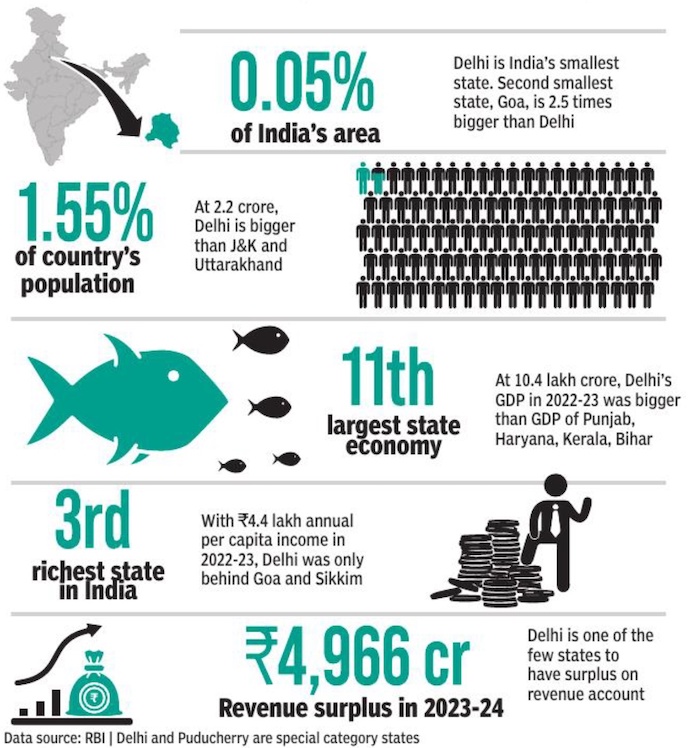
From: March 5, 2024: The Times of India
See graphic:
Area, Economy, Population, Wealth, state-wise statistics, 2022-23
Government finances
2012-18

Receipts and expenditure
From: March 23, 2018: The Times of India

Tax revenues as % state GDP;
Expenditure on establishment
From: March 23, 2018: The Times of India
See graphics:
Government finances, Delhi: 2012-18
Receipts and expenditure
Fiscal surplus or deficit as % of Delhi's state GDP, 2013-18;
Tax revenues as % state GDP;
Expenditure on establishment
Excise collections
2017, 2018/ Q2

From: AlokKN Mishra, July 26, 2018: The Times of India
See graphic:
Excise collections in Delhi, April- July, 2017, 2018
2015-19: tax collection
Paras Singh, January 4, 2019: The Times of India
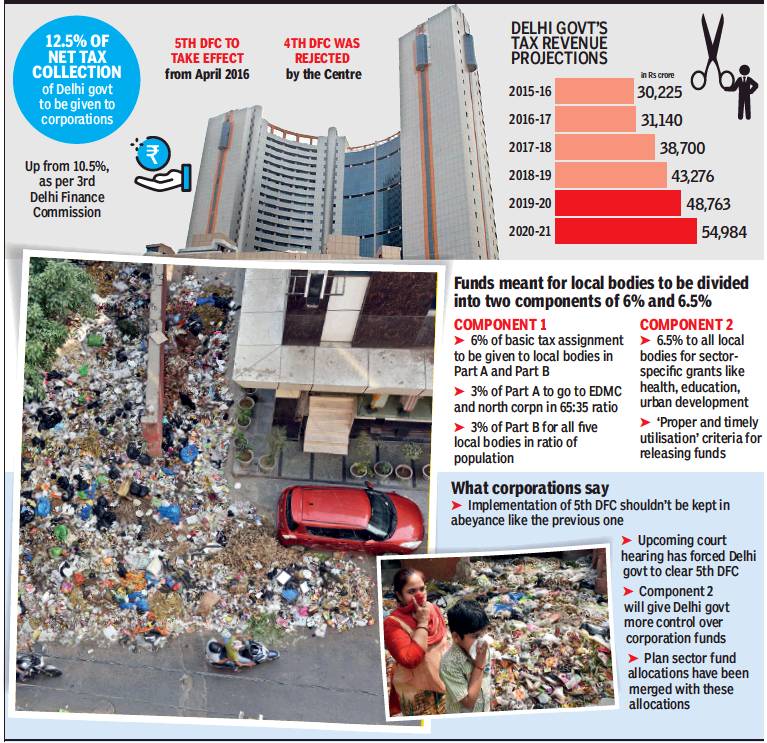
From: Paras Singh, January 4, 2019: The Times of India
Finance officials of the east corporation say that though they will be better off compared to the 3rd DFC allocations, the fund distribution was much better for them under the 4th DFC recommendations. They estimate that they will get approximately Rs 900 cr against an allocation of Rs 590 cr under the 3rd DFC. “Under the 4th DFC, east corporation was to get 42% of the total funds being given to all three civic bodies while now we will get only 35%. East Delhi will be at a disadvantage,” rued the official.
Under the new arrangement, officials said, the intercorporation distribution formula of the 4th DFC for the entire 12.5% devolution of funds has been applied on 6%. “The plan fund allocations (in education, health sectors), which were earlier a separate component, have now been scrapped. The funds for these sectors will now be made a part of these devolution allocations. A Delhi government committee will decide on the allocations annually,” the official added.
A senior south corporation official said that fund allocations have not been proportionately increased keeping the 4th DFC in mind. “The south corporation has got a bad deal. We suffer both in terms of not getting arrears and getting zero funds under the 3% component which is meant for the cash-strapped bodies,”’ he said. “Contrary to popular perception, the finances of SDMC are not in a very good state. A recent report by the municipal valuation committee has projected a revenue deficit of Rs 7156 cr in 2020-21.”
2017, 2018/ government finances
Alok KN Mishra, Tax evasion down, Delhi’s revenue up, November 22, 2018: The Times of India

From: Alok KN Mishra, Tax evasion down, Delhi’s revenue up, November 22, 2018: The Times of India
In the first two quarters of the current financial year, Delhi government collected Rs 21,000 crore in taxes. The total tax generation in the corresponding period in the last financial year was Rs 19,869 crore. Sources in the government said that the implementation of the e-Way bill seems to have played a key role in boosting tax collection by increasing better compliance of the Goods and Services Tax. Stamps and registration fees and land revenue have also recorded growths.
The e-Way bill, the electronic document generated on the GST portal for the movement of goods valued higher than Rs 50,000, has played a key role in preventing tax evasion. It has also ensured that the transactions complied with the GST laws.
A government official said that the major factor behind the rise in revenue is the easy tax scrutiny facilitated by the GST regime. The Aam Aadmi Party government, however, maintained that the revenue collection has increased because “the government is honest.”
The revenue department, which manages the sale of stamps and registration fees and land revenue, returned a collection of Rs 2,617.6 crore, a big increase from Rs 2,280.9 crore in 2017-18. This is 60.9% of the budget estimate under this head.
Revenue collected by the excise & entertainment tax department on commodities and services in the first two quarters of this year also went up from Rs 2,648.1 crore last year to Rs 2,794.2 crore. This figure represents 53.7% of the budge estimate.
The tax collected by the transport department has gone down slightly. In 2017-18, the department collected Rs 1,220.1 crore as taxes on vehicles, but till the second quarter this year, it had collected only Rs 1,160.6 crore, or 46.4% of the budget estimate.
An official described the tax collection in the two quarters of the year as ‘impressive’ and ‘indicative of good revenue generation for the government’, which will ultimately help the government fund its various schemes and projects.
While the robust collection augurs well for the departments with schemes to implement, there is no likelihood, however, of budgets for some departments being decreased in the revised budget estimates being currently prepared. The revised budget estimate will be presented in the winter session of the Assembly. In case of poor revenue collection, the budgets for some departments, mostly for low priority projects, are normally cut in the revised estimates.
Since coming to power in 2015, the AAP government’s budgetary expenditure has been growing steadily, and has gone from Rs 41,129 crore in 2015-16 to Rs 53,000 crore in 2018-19. In 2016-17, it was Rs 46,600 crore, rising to Rs 48,000 crore in 2017-18. Delhi government has earmarked the largest shares of allocations for education and health.
Statistics on GSDP, revenue surplus, Central grants, loans
Atul Mathur, Dec 3, 2019 The Times Of India
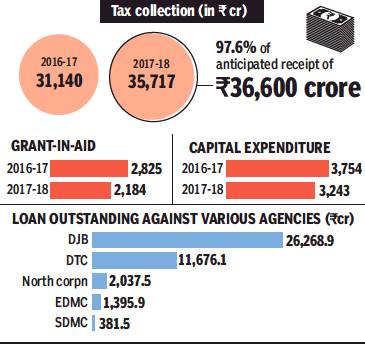
From: Atul Mathur, Dec 3, 2019 The Times Of India
Delhi continues to be in the pink of financial health with revenue remaining surplus over the last five years. This was stated by the CAG audit report on the state’s finances for the year ending March 31, 2018, which was tabled by deputy CM Manish Sisodia in Delhi assembly on Monday. The annual growth rate of Gross State Domestic Product (GSDP) at both current and constant prices was higher than that of India’s GDP in 2017-18. Interestingly, the fiscal deficit of Rs 1,051 crore in 2016-17 turned to surplus of Rs 113 crore in 2017-18 and stood at 0.02% of GSDP.
While revenue receipts (tax as well as non-tax) registered an increase in 2017-18, the grants in aid from the Centre saw a marginal decrease. While revenue expenditure witnessed an increase in 2017-18, capital expenditure on big ticket projects came down from Rs 3,754 crore in 2016-17 to Rs 3,243 crore in 2017-18.
The GSDP in 2017-18 was Rs 6,86,017 crore and grew at a rate of 15.4% in the past decade compared to the average national GDP growth of 12.9%.
The audit report noted that tax revenue and non-tax revenue registered an increase of 14.7% and 101.1%, respectively, over the previous year. However, the grants in aid received from the Centre decreased from Rs 2,825 crore in 2016-17 to Rs 2,184 crore in 2017-18. This included grants from the Centre in lieu of share in central taxes, which has remained stagnant at Rs 325 crore since 2001-02 although the central tax collection has grown substantially.
The report also pointed towards slow recovery of loans disbursed by the government to municipal corporations, Delhi Transport Corporation (DTC) and Delhi Jal Board (DJB). Against the loans amounting to Rs 26,620 crore disbursed to DJB during 1998-2018, only Rs 351.2 crore was repaid. The outstanding amount as on March 31, 2018 was Rs 26,268.9 crore. DTC was disbursed Rs 11,837.7 crore during 1996-2011, but it had paid only Rs 161.6 crore till March 31, 2018. Similarly, the north, east and south municipal corporations had outstanding loans of Rs 2,037.5 crore, Rs 1,395.9 crore and Rs 381.5 crore, respectively, till March 31, 2018.
2021-22

From: Alok KN Mishra, March 10, 2021: The Times of India
See graphic:
Highlights of budget, 2021-22
Govt budget: where the money comes from; where it goes
2024

From: March 5, 2024: The Times of India
See graphic:
The Delhi Govt budget, 2024: where the money came from; where it went
Growth (of city)
2001-2011: Delhi gobbled up villages to grow
Sex ratio, 1901-2011; census towns, 2001, 2011
One Third Of Population In Urbanized Villages In Lal Dora Areas That Doubled In Past Decade
Rukmini Shrinivasan TIG 2013/06/12
New Delhi: The capital’s growth in the decade 2001-11 has overwhelmingly come from the city swallowing up rural areas, newly released census data shows. The number of census towns—essentially newly urbanized villages in the lal dora areas—nearly doubled over the last decade, taking the proportion of Delhi’s residents who live in these areas to an unprecedented third of the population.
Varsha Joshi, director of census operations for Delhi, released the Primary Census Abstract for the National Capital Territory of Delhi on Tuesday. PCA gives the final population totals for every ward and village in NCT, as well as their literacy rates and sex ratios; provisional numbers were released last year.
The census redefines a village as a census town when it is densely populated and over three-quarters of its men work outside agriculture. In 2011, India had 3,894 census towns, home to half its urban population. The new numbers show that nearly 50 lakh people in Delhi, of a total population of 1.6 crore, live in census towns, which range in size from the 1,178-strong Shakarpur Baramad in east Delhi to Karawal Nagar, home to 2.24 lakh people, in north-east Delhi.
In 2001, 25 lakh people lived in Delhi’s census towns and they formed 18% of the population. By 2011, the proportion of rural residents in NCT had shrunk to just 2.5%. Simultaneously, the number of census nearly doubled to 110. About 30% of the NCT’s population now lives in these census towns. In fact, of the 29 lakh people added to Delhi’s population in the last decade, 24 lakh were added in census towns alone.
Of Delhi’s nine districts, north-west has seen the highest growth in population (22%) and is Delhi’s most populated district with over 36 lakh residents. Over 35% of the north-west lives in census towns. Saraswati Vihar in north-west Delhi has the highest population of any of the NCT’s 27 sub-divisions. Both New Delhi and central Delhi on the other hand have fewer residents than in 2001.
Population numbers at the ward level show that just four years after delimitation, the population of different wards varies wildly, from 1.5 lakh residents in Hastsal to just 15,000 in Kashmere Gate, which saw large-scale slum demolitions.
As The Times of India had reported earlier, Delhi has India’s lowest female workforce participation rate, with just 8.25 lakh women or roughly 10% reporting as workers. In contrast, there are 48 lakh male workers; over half of males across ages in the NCT report as workers. Seelampur reports the lowest female workforce participation of just over 5%. “We took a lot of steps to improve enumeration of women workers, but this is still what we have found. It’s really something we are worried about,” Joshi said. Over 95% of Delhi’s workers are ‘main workers’, meaning that they do economically productive work for over six months in the year. Connaught Place has the highest work participation rates for both men and women.
The proportion of scheduled castes in Delhi’s population has remained nearly constant at 16.75%.
Growth of economy
2012-17
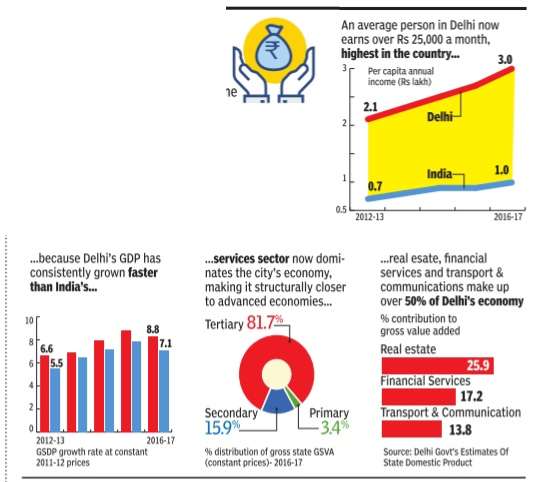
See graphic, ' Economy, Delhi, 2012-13 and 2016-17 '
2013: Jobs, Economy Growing Faster Than National Average
Delhi vis-à-vis other major states
TIMES NEWS NETWORK





This grphic shows Delhi’s lack of dependence on central grants vis-à-vis the greater dependence of other states
The Times of India, March 9, 2017
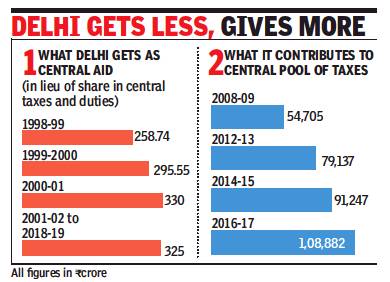
What Delhi received as Central Aid; and
What Delhi contributed to the Central pool of taxes
From: October 6, 2018: The Times of India
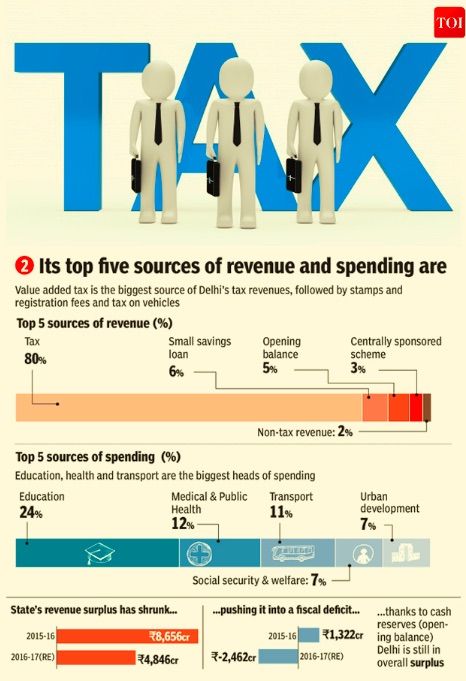

2013: Services once again accounted for the largest share (81.54%) of Delhi’s state gross domestic product (GSDP) in the previous financial year, according to the report “E s t i m a t e s o f S t a t e D o m e s t i c P r o d - u c t — 2 0 1 2 - 1 3 o f D e l h i ” compiled by the Directorate of Economics & Statistics .
The report said Delhi has become the most attractive city for youths seeking work across the country, thanks to her government’s pragmatic economic policies. It added that the 17.7% growth in Delhi’s GSDP, compared to 13.3% at the national level, reflects the city’s economic health. After accounting for inflation, the growth amounts to 9%, compared to 5% at the national level. The report states that Delhi’s GSDP is the 10th largest in India.
The predominance of services in Delhi’s economy is in line with the city’s industrial policy that promotes non-polluting units. The secondary sector (industry) contributes 17.69% and the primary sector (agriculture) 0.77% of the GSDP, the report states.
Finance, insurance, real estate and business services make up 40.23% of the service pie, followed by trade, hotels and restaurants with 18.24%, and construction (9.97%). Large-scale construction across the city has increased the contribution of this sector.
The report states that the ratio of Delhi’s GSDP to the all-India GDP at both current and constant prices has increased steadily. Delhi contributes 3.87% of the national GDP with only 1.42% of the population. Since 1998-99, Delhi’s GSDP has risen from Rs 53,226 crore to Rs 3.65 lakh crore—an increase of 687% “during the last 14 years of the present government,” a statement from the CM’s office stated.
Per capita income in Delhi is Rs 2.01 lakh compared to Rs 1.73 lakh in 2011-12—an increase of 15.77%. It is three times the national average of Rs 68,747. Per capita income crossed the Rs 1 lakh mark in 2008-09, and increased to Rs 1.27 lakh in 2009-10. In 1998-99, it was only Rs 40,060.
Growth: per capita income
Delhi's per capita income highest in India: Report
PTI | Aug 31, 2013
NEW DELHI: Delhi's average per capita income, at more than Rs 2 lakh per year in 2012-13, is the highest in India, a official report said Saturday.
"The average per capita income in Delhi is nearly three times the estimate for the all India average. During the seven year period from 2005-06 to 2012-13, it grew at the rate of about seven percent per annum vis-a-vis around three percent for India," said the Delhi Human Development Report 2013.
"The sustained growth in per capita income has been associated with a reduction in poverty to single-digit figures to 9.9 percent in 2011-12 from approximately 13 percent in 2004-05," it added.
Industry
2012-13: Factory output increases 13.7%

The Times of India, Sep 09 2015

City's factory output increases by 13.7%
3,183 Units Employ Nearly 1.26L Workers
Delhi witnessed a 13.7% growth in its factory output in 2012-13. There were around 1.26 lakh workers, mostly engaged in the areas of leather, textile and apparel manufacturing as well as repairing of vehicles during this period.
Of 3,183 factories, 1,022 came into existence after 2000 and 134 after 2011. About 1,266 factories are classified as private limited companies, 1,055 are under individual proprietorship and 775 are under partnership, said deputy CM Manish Sisodia while releasing a report on Annual Survey of Industries 2012-13.
The total output of 3,183 factories increased from Rs 50,900 crore in 2011-12 to Rs 57, 858 crore in 2012-13. The value of input material used in these factories increased from Rs 43,949 crore in 2011-12 to Rs 49,024 crore in 2012-13.
“The total emoluments paid to these employees increased from Rs 2,260 crore to Rs 2,577 crore,“ says the report prepared by the directorate of economics & statistics of the Delhi government.
The average emoluments per employee working in the registered factories were a mere Rs 2.04 lakh, just about Rs 17,000 a month. The data also shows that even those work ing in the organized sector are earning less than Rs 20,000 a month. The district-wise average shows that the all-inclusive package lacks uniformity .
For instance, the highest annual emoluments were recorded in Central district where it was Rs 5.58 lakh per annum followed by Rs 2.87 lakh in Southwest district, Rs 2.20 lakh in East district and Rs 2.03 lakh in West district. North district recorded the lowest income of Rs 1.59 lakh per annum.
The report reveals that in 1,426 factories, the number of workers in each factory is 100 or above. In 204 factories, the number of workers is 500 and above. Sisodia said the total number of employees working in these factories increased from 1.19 lakhs in 2011-12 to 1.26 lakhs in 2012-13.
Inflation
2007-15: Rise of wholesale prices of foodstuffs
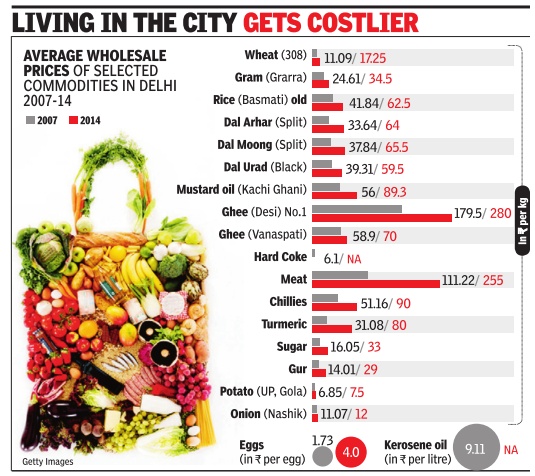
The Times of India, Jun 25 2015
Neha Lalchandani
In 7 years, prices of pulses, oil & mutton nearly doubled
In the past seven years, the prices of many food items seem to have doubled in Delhi. The Economic Survey of Delhi for 2014-15 shows that pulses, oil and even mutton are now twice as costly . Interestingly, Delhi's consumer price index during 2014 at 223 was lesser than the national average of 247, indicating that inflation in Delhi since 2001 has actually been lower than in most other cities. The survey , however, shows that potato and onion have registered an insignificant rise in their wholesale price since 2007 onion has gone up from Rs 1,107 per quintal to Rs 1,200 per quintal while potato is up from Rs 685 per quintal to Rs 750 per quintal. Against this, the price of pulses has risen exponentially in the wholesale market and its impact has been felt more acutely in the retail market. Arhar has gone up from Rs 3,365 per quintal to Rs 6,400 per quintal while price of moong has risen from Rs 3,784 per quintal to Rs 6,550 per quintal.
“Barring seasonal fluctuations in some commodities like onion, potato and wheat due to decline in arrivals, inclement weather in the major producing areas, transportation bottlenecks, increase in cost of movement and lower stocks the retail prices of most essential commodities have exhibited a steady trend in all metro cities in India.“ It has attributed the rise in prices to low production, market inefficiencies, wastage due to inadequate storage facilities etc.
In the case of pulses, Naresh Gupta, president of the grain merchants association, says a change in the minimum supply price has been instrumental in the sharp rise in prices, but more importantly , a shortage in supply is responsible for the rise in the price of grains. “Moong is the major crop grown in India but the rest is largely imported.The dollar exchange rate has also gone up significantly in he past 10 years. When we have been unable to meet demand, the prices will, of course, rise,“ he said.
Labour and migration
1999-2000 to 2011-12
See also Delhi: migration to
The tightening of the labour market has contributed to the lowering of poverty.
During 1999-2000 to 2011-12, an additional 1.3 million people were added to Delhi's workforce taking the total figure to 5.56 million.
Although, the rate of migration has stabilized in Delhi during the last decade, around 75,000 people still come to Delhi every year in search of a livelihood, said the report.
"The city has absorbed the migrants rather well, with the migrants rating themselves better than the non-migrants in terms of several indicators of well-being," it said.
While one third of the migrant population perceived that work opportunities in Delhi had improved over the last three years, two thirds of households considered their income to be stable.
Rules that curb ‘development’
The Times of India, Sep 05 2015
Risha Chitlangia
Muddled rules stall city's growth
Policies not framed with ground realities in view, difficult to implement
Residents of Golf Links and Sunder Nagar are resisting the de-notification of these areas from Lutyens' Bungalow Zone (LBZ). They say the upscale colonies will become commercialized like other residential areas and the density of population will increase once the development norms of Master Plan for Delhi-2021 become applicable to them. “Bigger buildings will be allowed without increasing the infrastructure,“ a resident of Golf Links said.
While Delhiites appreciate the government's decision to increase the floor area ratio (FAR) and the height of buildings in MPD-2021, they say growth of infrastructure is not keeping pace with the pressure of population.
“It should have been binding on the civic agency to augment the civic infrastructure while sanctioning plans as per the new development norms. Due to lack of enforcement, people are blatantly violating norms,“ said Chetan Sharma, chairman, GK-II RWA complexes. Problems like parking, waterlogging, shortage of drinking water, etc., have worsened after the new provisions were implemented.MPD-2021 requires that the civic agencies upgrade their infrastructure but this isn't happening.
MPD recommended redevelopment of plotted areas to meet the growing demand for houses in a planned way. But it placed the condition that the minimum plot size should be 3,000 sqm, which is nearly impossible to achieve, so only a government project in Kidwai Nagar has been approved so far. “It is a good provision, but difficult to achieve under the present norms as 3,000 sqm is a huge area,“ said A K Jain, former planning com missioner of DDA. He added that the redevelopment norms should be made peo ple-friendly.
In villages, redevelop ment can be done on a plot of 1,670 sqm or more.
Residents say the develop ment norms are not in sync with the ground realities and should be framed after study ing the problems faced by the residents. For instance, there is a need to combine small plots for redevelopment. At present, only plots measur ing up to 64 sqm can be com bined in villages, industrial areas and some parts of Rohini but the government is likely to raise the limit to 200 sqm.“There are many small plots in the city. People should be allowed to amalgamate plots and reconstruct. The provisions have to be implemented in the right spirit,“ said Neeraj Gupta, president of Hblock RWA in New Rajinder Nagar.
Rules related to subdivision of plots are also impractical as the FAR of the smaller plots is based on the size of the original plot. Municipal corporation officials say building plans are not being sanctioned in unauthorized regularized colonies and villages due to this rule. People in these colonies are building illegally as they can't get the FAR that other colonies are allowed.
“Although the provision recognizes each subdivided plot as a single entity, it doesn't allow FAR as per the MPD norms. In most cases, the permissible FAR is used up by the other subdivided plots, leaving little scope to construct on available vacant land, said a senior South Corporation official.
Experts say there is a need to reconsider the development provisions so that people can get their plans sanctioned without any hassle.
Sex ratio
Elsewhere on this page see the graphic, Delhi’s census towns, and population density, in 2001 and 2011
Sex ratio in Delhi, 1901-2011.
2011
In 2011 Delhi had a higher proportion of women in its population than it has had at any time in over a century. The sex ratio – number of females of all ages for every 1,000 males – was 868 in 2011, the first time that it has crossed 862, the previous highest set way back in 1901. This change has taken place despite no significant improvements in Delhi’s child sex ratio which stands at 871 girls for every 1,000 boys between the ages of 0 and 6. The figure for 2001 was only marginally lower at 868. There seemed to be more family migration taking place and fewer single male migrants, Varsha Joshi, director of census operations for Delhi, had said earlier. That could partly explain the dramatic improvement in the overall sex ratio between 2001, when it was 821, and 2011.
Vis-à-vis other national capitals, 2018

From: June 1, 2021: The Times of India
See graphic:
Delhi’s Share in India’s national economy, Vis-à-vis other national capitals, 2018
Socio-economic composition of Delhi
2018 -2019
January 16, 2021: The Times of India
‘Unemployment rate 16.3%, nearly 10% kids out of school’
New Delhi:
The city has an unemployment rate of over 16% and nearly 10% children in the age group of 6-17 do not attend school primarily due to financial constraints, according to a Delhi government survey. The survey titled “Socio-Economic Profile of Residents of Delhi” was conducted between November 2018 and November 2019 and covered 1.02 crore people in Delhi.
The report, which was finalised in November 2020, reveals the socio-economic composition of the city, including details on religion, caste, income, education, chronic illnesses, status of vaccination, employment and preferred modes of transport.
According to the survey, Delhi has an unemployment rate of 16.3%. “Among the children in the age group of 6-17, 9.8% are reported to be out of school, including dropout, discontinued and never attended categories. The predominant reason for not attending school in the age group of 6-17 years is reported as financial constraint,” it said.
The report added, “92.5% of adolescent girls within the age group of 11-14 in Delhi are reported to be attending educational institutions. In total, 7.5% of adolescent girls in the age group of 11-14 are out of school, it said.
While over 78% of people are getting medical treatment at government hospitals and dispensaries, over 77% children up to the age of 5 receive vaccination. Over 69% of the population in Delhi uses public transport, including Metro. PTI
Tax bases
Property tax

Mayank Manohar, House tax waiver will paralyse corps: Experts, March 26, 2017: The Times of India

See graphics
Key sources of revenue in Delhi.jpg|Key sources of revenue in Delhi
Property tax in Delhi: statistics, 2012-17
Delhi CM Arvind Kejriwal's announcement that AAP will do away with the property tax collection from residential units and waive dues of all defaulters if it wins the civic elections has not gone down well with former municipal commissioners and ruling party leaders in the corporations. They claim that the step will weaken the revenue generation mechanism of the municipalities and “effectively paralyse the civic bodies“.
In 2004, when the unit area method was introduced by the erstwhile MCD, the colonies were divided into different categories from A to H. The base unit area value was fixed depending on their location and the nature of area. For instance, the base unit area value for A-category colonies is Rs 630 (maximum) and while this is Rs 100 (minimum) for H-category ones. Former municipal commissioner Rakesh Mehta cla ims if property tax is not collected from residential colonies, the concept of categorisation will become meaningless.In that case, services given to people living in Greater Kailash will be the same as that of Seelampur, he said.
As of now only 30-35% of the entire Delhi's population is paying property tax while the remaining 65-70% are not in this tax bracket. The property tax is collected from residential, commercial and industrial units as well as mixed land use.The south corporation has 4.75 lakh tax payers among its 11 lakh households. The north civic body has approximately 3.35 lakh property tax payers among 10 lakh properties un der its jurisdiction while the east corporation has 2.28 lakh tax payers out of over four lakh property owners.
In 2016-17, the south, north and east corporations collected Rs 775 crore, Rs 435 crore and Rs 128 crore respectively , which is almost 30% of their total revenue. The revenue collected as property tax helps the corporations in providing services to the public.
“In every country , local bodies collect taxes. This is because the government provides only a portion of the total revenue and the civic bodies have to arrange the rest of the funds themselves. Services like sanitation, primary education and health will be badly affected if property tax is abolished,“ said Mehta.
K S Mehra, another excommissioner, said the basic logic for civic bodies to have revenue sources is to ensure that they can become self-reliant.“Property tax has always been a major source of revenue and the collection should be increased instead of doing away with it,“ he said.
Post trifurcation, a large number of number of A and B category colonies came under the south corporations, while the north had mostly B and Ccategory colonies and the east corporation was left with a good number of E,F ,G and Hclass colonies.
“Property tax is a major re venue source. If this step is implemented, alternative measures are required to fill the revenue gap and to ensure that civic bodies don't get into financial trouble. The south corporation is financially stable because it has seen a huge rise in the property tax collection,“ said Radha Krishnan, assessor & collector of SDMC.
Senior officials warn that the cash-strapped north and east civic bodies will face further crisis if the property tax waiver comes into effect. “We are already financially weak and if we stop collecting property tax from residential units, we will never be able to deal with the situation,“ said a senior finance official (east corporation).
Senior leaders said that such a move will paralyse the functioning of corporations and they will never be able to become self-reliant. “If civic bodies stop collecting taxes, how are we going to extend services to the public,“ asked V P Pandey , leader of the House (north).
Unemployment
1997-2015
Number of jobless people on the rise, Mar 08 2017, The Times of India
The Economic Survey 2016-17 shows that the number of unemployed in the capital has been rising consistently since 2010. There were over 10 lakh jobless people in 2014 and 2015.Unemployment growth rate was the lowest at 6.51% in 2015, as compared to the last four years.
In 2015, the total unemployed people in Delhi were 10,83,896. This number was 10,17,569 in 2014. Between 1997 and 2015, there were phases when the number of unemployed youth declined. However, after 2010, when there were 4,93,384 unemployed, the number has only been rising.It shot up to 7,74,569 in 2012 and went up to 8,55,292 in 2013.
In 2011, the growth rate of unemployed persons over the previous year was a steep 30.39%. The growth rate was 20.41% in 2012, 10.42% in 2013, 18.97% in 2014 and 6.51% in 2015.
See also
Delhi: Economy

